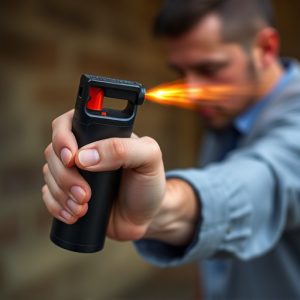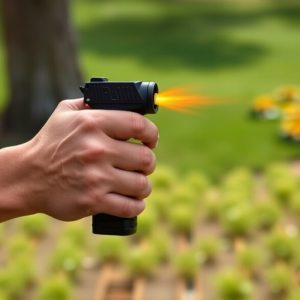Capsaicin-Based Protection: Navigating Pepper Spray Laws and Effectiveness
Pepper spray, derived from chili peppers, is an effective self-defense tool that triggers irritation…….
Pepper spray, derived from chili peppers, is an effective self-defense tool that triggers irritation in assailants. Its legal availability varies widely across US states, with regulations centered on public safety and self-defense rights. Understanding state-specific Pepper Spray Laws before purchasing or carrying a device is essential to ensure compliance and responsible use. These laws govern possession, use, and carry locations, with some states allowing open carry without permits while others mandate licenses. Choosing the right pepper spray involves considering factors like range, potency, ease of use, and portability, tailored to individual needs and local regulations. Responsible use includes secure storage, understanding legal limits, careful deployment at a safe distance, and recognizing its temporary disabling effect without permanent harm.
“Discover the power of nature’s defense mechanism with our in-depth look at capsaicin-based personal protection devices. This article explores the science behind capsaicin, commonly known as the active ingredient in pepper spray, and its effectiveness as a non-lethal self-defense tool. We navigate the legal landscape of pepper spray laws by state, ensuring you understand your rights and responsibilities. From device types to safety considerations, this comprehensive guide equips you with knowledge for informed decisions regarding personal protection.”
- Understanding Capsaicin: The Active Ingredient in Pepper Spray
- Legal Landscape: Pepper Spray Laws by State
- How Pepper Spray Devices Work and Their Effectiveness
- Types of Personal Protection Devices Using Capsaicin
- Safety Considerations and Responsible Use of Pepper Spray
Understanding Capsaicin: The Active Ingredient in Pepper Spray
Capsaicin, the active ingredient in pepper spray, is a natural compound derived from chili peppers. It’s what gives pepper spray its potent irritant properties, making it an effective personal protection device. When sprayed, capsaicin triggers a reaction in the human body by binding to specific receptors in the nose and eyes, causing intense irritation and temporary incapacitation. This chemical substance is widely recognized for its use in law enforcement and self-defense products due to its ability to disrupt an assailant’s vision and mobility.
Understanding capsaicin is crucial when considering pepper spray as a personal safety measure. Each state in the US has its own Pepper Spray Laws by State, regulating the possession, use, and restrictions of pepper spray for civilians. These laws vary regarding permitted quantities, application methods, and where it can be carried, so it’s essential to research and comply with local regulations before purchasing or carrying any pepper spray device.
Legal Landscape: Pepper Spray Laws by State
The legal landscape surrounding pepper spray in the United States varies greatly from state to state, with each having its own set of regulations and restrictions on the use and possession of this personal protection device. Understanding these Pepper Spray Laws by State is crucial for individuals looking to arm themselves with a non-lethal deterrent. Some states, like Texas and Florida, have relatively relaxed rules, allowing citizens to carry pepper spray for self-defense without a permit. In contrast, California and New York have stringent regulations, often requiring permits or special training to possess and use pepper spray legally.
These variations are driven by differing perceptions of public safety and the potential risks associated with pepper spray. States with more permissive laws often prioritize individual freedom and right-to-self-defense, while those with stricter regulations may focus on curbing misuse and accidental discharge. Navigating these Pepper Spray Laws by State is essential for responsible citizens looking to protect themselves and ensure they remain within legal boundaries.
How Pepper Spray Devices Work and Their Effectiveness
Pepper spray devices operate by releasing a potent chemical compound known as capsaicin into the air, which is the active ingredient found in chili peppers. When inhaled or contacted with sensitive areas like eyes and respiratory passages, capsaicin triggers a burning sensation and temporarily incapacitates an individual, providing users with a crucial window of opportunity for escape or self-defense. The spray creates a fog-like cloud that can disrupt an assailant’s vision and breathing, allowing the user to retreat to safety.
The effectiveness of pepper spray devices varies based on factors such as distance, wind conditions, and the individual’s tolerance to capsaicin. According to studies and real-world applications, pepper spray has been shown to be highly effective in neutralizing aggressive dogs and dissuading potential attackers. Moreover, Pepper Spray Laws by State vary significantly, with some states allowing its use for self-defense while others have stringent regulations or even bans on civilian possession. Understanding these laws is crucial for responsible usage and ensuring compliance with local regulations.
Types of Personal Protection Devices Using Capsaicin
Personal protection devices utilizing capsaicin, commonly known as pepper spray, offer a powerful and legal self-defense option for individuals across various situations. These devices come in several types, each designed to meet specific needs, whether it’s for everyday carry, outdoor adventures, or specialized professions. One of the key advantages lies in their legality; understanding Pepper Spray Laws by State is essential as regulations vary widely. Many states allow the open carry of pepper spray without a permit, while others have stricter requirements, such as requiring a concealed carry license.
The various types include aerosol sprays, typically delivered through a can, and advanced devices like electric pulse weapons that use capsaicin-laced projectiles or patches. Some even incorporate UV lights to disable attackers temporarily. Each design considers different factors like range, potency, ease of use, and portability, ensuring individuals can choose based on their level of comfort and the potential threats they may face.
Safety Considerations and Responsible Use of Pepper Spray
When considering a capsicum-based personal protection device, such as pepper spray, it’s paramount to understand and adhere to safety considerations and responsible use guidelines. Pepper spray can be an effective deterrent against potential threats, but its misuse or inappropriate handling can lead to unwanted consequences for both the user and bystanders. Always store pepper spray in a secure, out-of-reach location, especially if children or pets are present. Familiarize yourself with local Pepper Spray Laws by State to ensure compliance and avoid any legal repercussions.
Before deploying pepper spray, assess the situation carefully. Aim for the eyes, nose, and mouth of the assailant as these areas are most sensitive to capsaicin. Keep a safe distance, typically 2-3 feet, to minimize cross-contamination and ensure you can escape if needed. Remember, pepper spray temporarily disables but does not cause permanent harm, making it an invaluable tool for self-defense when used responsibly.
In light of the varying pepper spray laws by state, it’s clear that personal protection devices, particularly those utilizing capsaicin, offer a viable option for individuals seeking safety. Understanding the active ingredient, its effects, and proper usage is crucial to ensuring effectiveness. As we’ve explored, these devices can provide a powerful deterrent when used responsibly. Always stay informed about local regulations to make an educated decision regarding personal protection.


